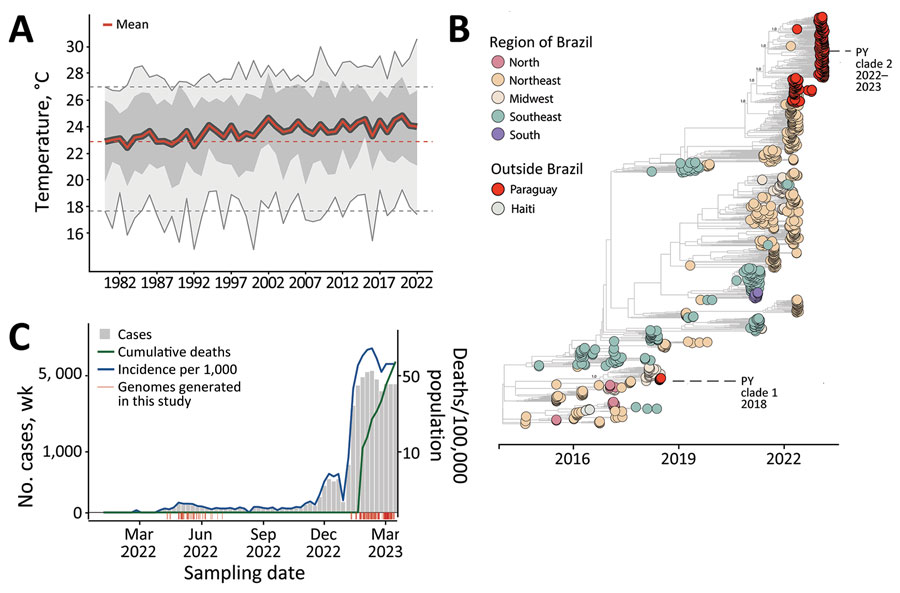Rapid Epidemic Expansion of Chikungunya Virus East/Central/South African Lineage, Paraguay
Marta Giovanetti
1
, Cynthia Vazquez
1, Mauricio Lima
1, Emerson Castro
1, Analia Rojas, Andrea Gomez de la Fuente, Carolina Aquino, Cesar Cantero, Fatima Fleitas, Juan Torales, Julio Barrios, Maria J. Ortega, Maria L. Gamarra, Shirley Villalba, Tania Alfonzo, Joilson Xavier, Talita Adelino, Hegger Fritsch, Felipe C.M. Iani, Glauco C. Pereira, Carla de Oliveira, Gabriel Schuab, Evandra S. Rodrigues, Simone Kashima, Juliana Leite, Lionel Gresh, Leticia Franco, Houriiyah Tegally, Wesley C. Van Voorhis, Richard Lessels, Ana Maria Bispo de Filippis, Andrea Ojeda, Guillermo Sequera, Romeo Montoya, Edward C. Holmes, Tulio de Oliveira, Jairo M. Rico, José Lourenço, Vagner Fonseca, and Luiz C.J. Alcantara
Author affiliations: Università Campus Bio-Medico di Roma, Italy (M. Giovanetti); Instituto Oswaldo Cruz, Belo Horizonte, Brazil (M. Giovanetti, M. Lima, E. Castro, J. Xavier, H. Fritsch, L.C.J. Alcantara); Laboratorio Central de Salud Pública, Asunción, Paraguay (C. Vazquez, A. Rojas, A. Gomez de la Fuente, C. Aquino, C. Cantero, F. Fleitas, J. Torales, J. Barrios, M.J. Ortega, M.L. Gamarra, S. Villalba, T. Alfonzo); Central de Saúde Pública do Estado de Minas Gerais, Ezequiel Dias, Brazil (M. Lima, E. Castro, T. Adelino, F.C.M. Iani, G.C. Pereira); Universidade Federal de Minas Gerais, Belo Horizonte (J. Xavier, H. Fritsch); Instituto Oswaldo Cruz, Rio de Janeiro, Brazil (C. de Oliveira, G. Schuab, A.M.B. de Filippis); University of São Paulo, São Paulo, Brazil (E.S. Rodrigues, S. Kashima); Pan American Health Organization/World Health Organization, Washington, DC, USA (J. Leite, L. Gresh, L. Franco, J.M. Rico); Stellenbosch University, Stellenbosch, South Africa (H. Tegally, T. de Oliveira); University of KwaZulu-Natal, Durban, South Africa (H. Tegally, R. Lessels, T. de Oliveira); National Institutes of Health, Bethesda, Maryland, USA (W.C. Van Voorhis); Dirección General de Vigilancia de la Salud, Asunción (A. Ojeda, G. Sequera); Organización Panamericana de la Salud/Organización Mundial de la Salud Asuncion (R. Montoya); University of Sydney, Sydney, New South Wales, Australia (E.C. Holmes); University of Lisbon, Lisbon, Portugal (J. Lourenço); Organização Pan-Americana da Saúde/Organização/Mundial da Saúde, Brasilia, Brazil. (V. Fonseca)
Main Article
Figure 1

Figure 1. Spatial and temporal distribution of cases of chikungunya in Paraguay. A) Temperature trends during 1981‒2022. Yearly mean (red line), yearly minimum and maximum (light gray shading), yearly 50% quantiles (dark gray shading), minimum and maximum temperatures in 1981 (dashed gray lines) and mean temperature in 1981 (dashed red line) are shown. B) Number of chikungunya virus genome sequences in Paraguay compared with Brazil (by region) and Haiti. Size of circles indicates number of new genomes generated in this study. C) Weekly reported chikungunya cases (gray area), incidence normalized per 100,000 persons (blue line), and cumulative deaths (green line -or other color if you need to change this line color) during 2022–2023 (through epidemiologic week 11). Red bars indicate dates of sample collection of genomes generated in this study.
Main Article
Page created: July 14, 2023
Page updated: August 20, 2023
Page reviewed: August 20, 2023
The conclusions, findings, and opinions expressed by authors contributing to this journal do not necessarily reflect the official position of the U.S. Department of Health and Human Services, the Public Health Service, the Centers for Disease Control and Prevention, or the authors' affiliated institutions. Use of trade names is for identification only and does not imply endorsement by any of the groups named above.
